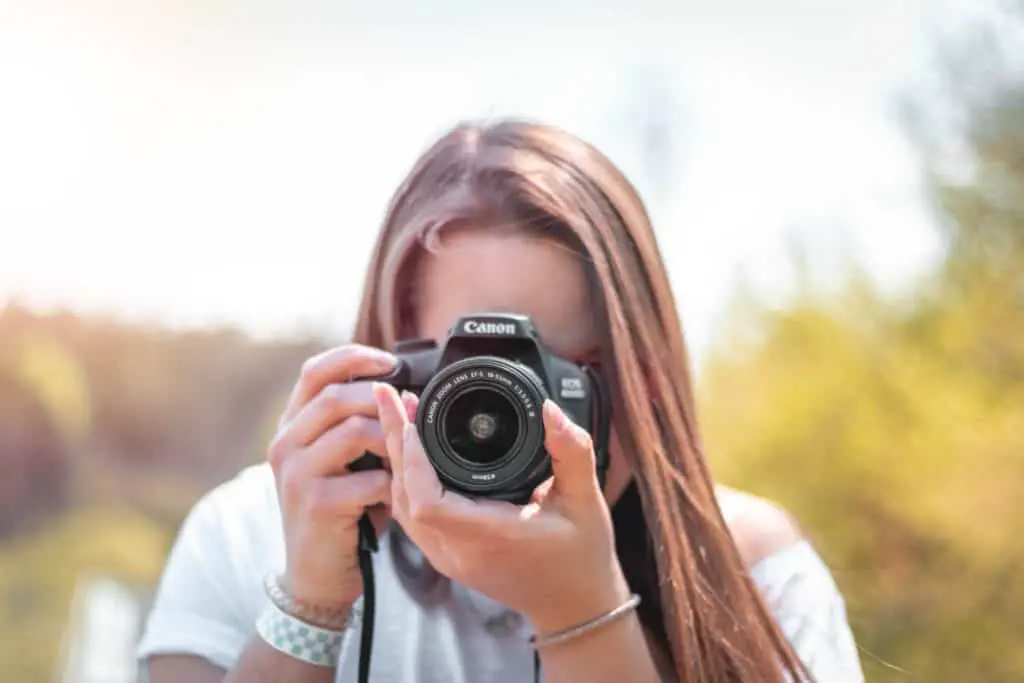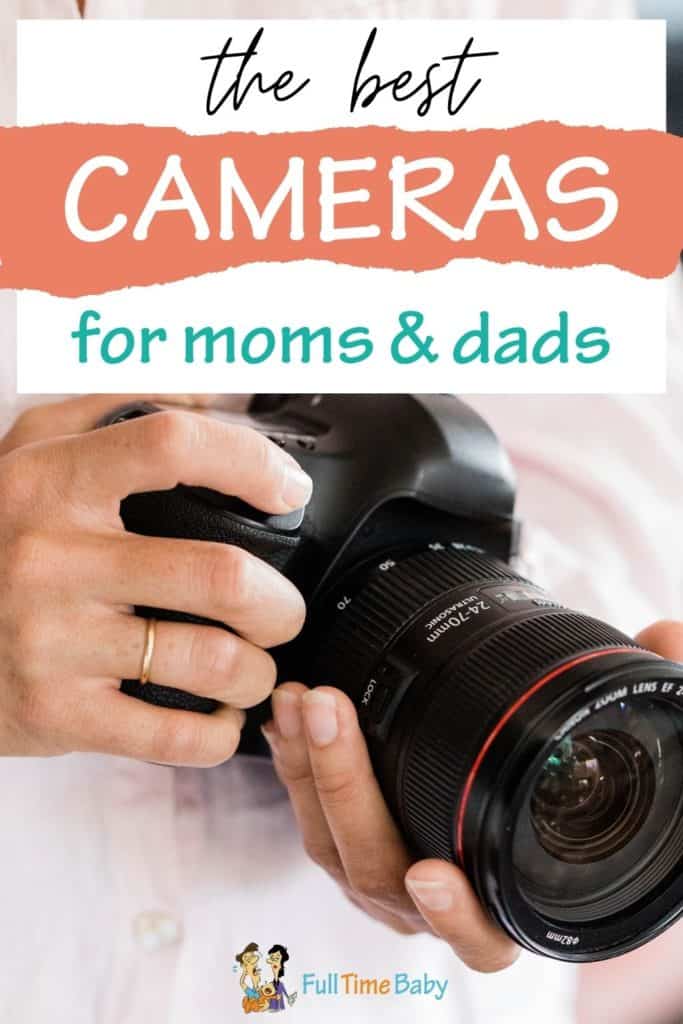“A mother’s work is never done.” You may have heard this line before. Moms have a lot on their plate and wear different hats. The titles keep piling up: House chef, manager, and even family photographer.
It starts with the firstborn. From the moment of giving birth, the priceless picture-perfect moments never end. Photos are precious documentation of a family’s memories. It’s worth learning more about photography and what the best cameras are for parents, including moms and dads.
How to choose the best camera for moms and dads
Your quest to find the right camera starts with getting clear with your needs.
Are you going to use it outdoors only? Are you considering using it for newborn photography or more of a lifetime camera to keep? Are there differences in the photo quality?
Keep reading so you’ll get to know about the differences between DSLR, mirrorless, point and shoot and smartphone cameras. This will guide you on what type of camera matches your needs.
What is a DSLR
The term DSLR is most commonly though of as a high end “professional camera”. Amateur to advanced photographers can use DSLR.
DSLR stands for digital single-lens reflex camera. It is only one type of camera that allows interchangeable camera lenses on the same camera body.
Advantages of DSLR Cameras
- Interchangeable lens. This is one of the best features of DSLR cameras. It will allow you to attach your choice of lens to the camera body. Each lens type serves a different purpose and will give you a different look, like wide-angle or extra zoom.
- Low light adaptable. A DSLR camera is reliable when shooting in low or dim lights. Its larger sensor can capture more light.
- High shooting speed. It has better autofocus for high-quality images even if the subject is moving fast. (especially true for your quick moving toddlers)
- Long battery life. DSLR cameras have longer battery life as well for they use minimal power.
- Depth of field. You have full control over the depth of field when using DSLR. This means that you can choose to isolate the foreground from the background or focus on everything the lens captures through the aperture settings.
- Durable construction. DSLR cameras are built to last. Most parts are made of magnesium alloy and can take a lot of bumps and falls.
Disadvantages of DSLR Cameras
- Size and weight. DSLR cameras are quite bulky and heavy compared to other camera types. The common body size and weight is 4.9 x 3.9 x 2.8 inches/12.9 ounces up to 5.83 x 4.37 x 2.91 inches/30.34 ounces. A baby and baby gear are plenty to lug around which makes this the biggest disadvantage for a parent.
- Complex control and settings. It can be overwhelming to use a DSLR camera, especially for beginners. It has various control buttons and settings. You will need more time to understand and learn all the functions of this camera.
- Higher price point. DSLR are more expensive cameras than other camera types. An entry-level DSLR can have a higher price than an advanced point and shoot camera. Add to that the accessories and lenses you will need in the long run.
- Noise. There is generally more noise every time the shutter opens and closes when using a DSLR camera, which could startle a sleeping baby. It’s because of the nature of its construction but some of the latest DSLR cameras have a quiet mode with a lower noise level.
Should you choose a DSLR
The decision will depend on your criteria which comes from your needs. As a mom who carries a child while pushing a stroller and sporting a diaper bag. The size and weight of a DSLR camera may be a concern for you. But if you’re looking to buy a camera that will last long years and can capture your energetic and fast-moving toddler, a DSLR camera may be a good option.
DSLR needs your time to learn the different features, settings and lens functions. If you’re a mom who doesn’t want to invest this effort, then you might need to look for other camera choices. But if you like high-quality images with full manual controls, a DSLR camera is for you.
What is a Mirrorless camera
Unlike DSLR cameras, a mirrorless camera is a digital camera that doesn’t have a reflex mirror. There also isn’t an optical viewfinder. The camera’s image sensor is always exposed to light. The way it captures images is much more like how a smartphone camera works. The LCD screen at the back of the camera, an electronic viewfinder (EVF) shows the preview of images.
It’s a compact system camera. Technically, point and shoot cameras fall under the category of mirrorless cameras. Today, the term “mirrorless” cameras often describe a digital camera without an interchangeable lens and optical viewfinder.
Advantages of Mirrorless Cameras
- Size and weight. The mirrorless camera is noticeably lightweight and more compact compared to a DSLR camera. It has no mirror or prisms that make it lighter and easier to carry around.
- Quiet operation. There are fewer moving parts in a mirrorless camera with its electronic rather than mechanical shutter. This makes these devices function quieter compared to a DSLR camera.
- Video resolution. Mirrorless cameras are more reliable in video mode. These cameras have on-chip phase detection focus sensors. Most DSLR cameras can’t use phase detection when the mirror is up while recording videos. This will have the DSLR to use slower and less accurate focus. It’s the reason why videos in most DSLR cameras become blurry in the middle of the video.
Disadvantages of Mirrorless Cameras
- Limited lens option. You can also change the lenses attached to the body of mirrorless cameras like the DSLR. But there are limitations in the variety of lens selection.
- Image stabilization. Mirrorless and DSLR cameras both have this technology to produce high-quality images at high speed. Mirrorless cameras have exceptional autofocus capability for facial recognition and selfies. DSLR cameras outperform in focusing on moving subjects with low lighting conditions.
- Battery life. The smaller size of mirrorless cameras requires a smaller battery, thus it has shorter battery life than DSLR cameras.
Should you choose a mirrorless camera?
A mom would like to buy a mirrorless camera if looking for a sleek version of the DSLR. Its size and weight make it good for travel and mobility. Its autofocus is also best for taking selfies and offers high video resolution. But if you want to learn to use different lenses with longer battery life, a mirrorless camera might not be the best option.
What are point and shoot cameras
A point and shoot cameras, like a DSLR and mirrorless, is a digital camera. It doesn’t need changing of lenses. The focus and exposure are fully automatic. It’s sometimes referred to as compact cameras because it’s generally smaller and lightweight than DSLR and mirrorless cameras.
Advantages of Point and Shoot Cameras
- Size and weight. Point and shoot cameras are compact in size and weight almost the same as smartphones. It can even for your pockets.
- Easy control and settings. It operates in automatic modes making it easier for moms to navigate the features and settings.
- Fixed lens. All point and shoot cameras come with fixed lenses. There’s no need to change lenses to get different effects or zoom.
Disadvantages of Point and Shoot Cameras
- Limited control. This can be a downside when you want to take more control in the process of taking photos. There is very little control over aperture and shutter speed.
- Dim light capability. Point and shoot cameras do not perform as well as DSLRs and mirrorless cameras when shooting in the dark or dim light.
- Inability taking wide-angle shots. Most point and shoot camera lenses start at 30-35mm. This means that you need to stand back a little more to get a wide-angle shot.
- Limited focus. Point and shoot cameras are not suited for fast action photos. The image stabilization and shooting speed of most point and shoot cameras are limited.
Is it time to buy your point and shoot camera?
A point and shoot camera will be compatible with moms who are not looking into very specific camera capabilities. with different lenses, shooting speed, lighting while being able to handle a sleek camera in their pockets.
Smartphone cameras
The most popular way moms capture photos is through their smartphone cameras. It essentially works similarly to point and shother types of cameras but with vast limitations compared to DSLR, mirrorless, and point and shoot cameras.
Advantages of Point and Shoot Cameras
- Convenience. You can always bring your smartphone and put it out quickly every time you need to take that photo of your kid. Its size and weight make it possible to keep it handy or in your pocket.
- Easy control and settings. Camera phones are easy to navigate and use. Most even have the hand and smile sensor or recognition when taking photos.
- Same time editing. One of the perks of using a smartphone camera is that you can edit photos on the go. Thanks to your favorite photo editing app, all you need to do is launch it and do any adjustments you’d like to make after taking the photo.
Disadvantages of Point and Shoot Cameras
- Limited features. It’s a good thing to have a fully automated smartphone but it still lacks most features to make every photo high quality. Even though most new versions of smartphones have the night mode or dim photo settings upgraded, there are still some lighting situations where a quality photo is somehow impossible to achieve.
- Small. The small size of smartphones makes it convenient to use but it’s also the reason why its camera has limited capabilities. The camera sensor is so small making the pixels that capture light to create an image are also small.
- Non-ergonomic shape. Photography is not the main function of smartphones. Smartphone’s ergonomics do not let you hold it tightly like how digital cameras are designed. You tend to hold your smartphone between the tips of your fingers which is not the most secure way to hold it.
Can you keep your smartphone for taking photos?
It’s beneficial to get a smartphone because it offers a lot of features other than photography. It has many purposes. But you might want to opt for buying a DSLR, mirrorless, or point and shoot camera as well if you’re looking to invest in high-quality photos and videos.
Best DSLR cameras for parents
Here are some of the top DSLR cameras in 2020. This will guide you in selecting the brand and model you’d like should you decide that your needs in taking photos require a DSLR.
Nikon D3500
One of the best entry-level DSLR cameras and Nikon’s latest version of an entry-level DSLR. It’s a good beginner’s camera and also Nikon’s cheapest, lightest and simplest DSLR. It has simplified controls and a built-in Guide Mode to help beginners learn and use the basics.
You can get good quality images with this camera that can shoot a full HD 1920×1080 video at up to 60/50fps. It has 5fps continuous shooting. However, it doesn’t use in-body stability but Nikon lenses come with a Vibration Reduction System. The rear LCD screen is not touch-sensitive. You will rely mostly on physical buttons and dials.
Nikon D3500 has limitations in its features but for its price and intended beginner photographer audience, it is a great starter DSLR.
Canon EOS 750D
Canon boasts many advanced DSLR models like the 2000D, but the EOS 750D could be a good beginner DSLR. It has a very laid-back control style. There’s just one manual control wheel on the top and easy to reach mode dial.
It’s easy to use for beginners but still gives you plenty of manual control. You can preview images in the 3 inch LCD at the back. The touchscreen support allows you to pick a focus point with a finger. It lets you shoot at 5fps with a 24 megapixels sensor.
One downside is the viewfinder that only lets 95% coverage of the screen.
|
DSLR Camera Brand and Model |
Megapixels |
ISO Range |
Image stabilization |
Video (Max Resolution) |
Shooting speed |
Display |
Wi-Fi |
Body Size & Weight |
Battery Life |
|
Nikon D3500 |
24.3 |
ISO 100-25,600 |
Auto focus: 11 points/Phase, Contrast, |
1080p/60 fps |
5 fps |
3-inch LCD 921,000 dots |
None. Bluetooth only |
4.9 x 3.9 x 2.8 inches/12.9 ounces |
1,550 shots |
|
Canon EOS 750D |
24.2 |
ISO 100-12800, 25600 |
None |
1920 x 1080 at 30p,25p,24p fps |
5 fps |
3.0 inch touchscreen with 1,040,000 |
Yes |
5.2 x 3.98 x 3.07 inches / 19.58 ounces |
440 shots |
Best mirrorless cameras for parents
Fujifilm X-T30
It’s arguably one of the best mirrorless cameras you could explore. It’s well built with a tilting touch screen LCD and direct controls that make it user-friendly. The tilting touchscreen allows for the tap to focus, touchpad AF and navigation of the customizable Quick Menu.
The image quality offers vibrant colors. The 26 megapixels sensor allows shooting at low ISO to retain highlights and brighten shadows. It is capable of face detection and continuous autofocus which is good for capturing active and fast-moving kids.
Video autofocus is also good, though the camera can only track faces.
Sony Alpha a7 III
It has 24 megapixels with BSI (backside-illuminated) and a dual gain design. This means that this camera allows maximum dynamic range in bright light or better noise performance in low light.
Sony Alpha a7 III can capture up to 10fps with full autofocus and auto exposure. Images are also sharp and crisp. It has a dull electronic shutter that makes it possible to shoot silently.
|
Mirrorless Camera Brand & Model |
Megapixels |
ISO |
Image stabilization |
Video (Max Resolution) |
Shooting speed |
Display |
Wi-Fi |
Body Size & Weight |
Battery Life |
|
Fujifilm X-T30 |
26.1 |
ISO 160-12800 (80-51200 extended) |
Yes |
DCI 4K (4096 x2160) at 30/24p |
30 fps |
3-inch touchscreen |
Yes |
4.7 x 3.3 x 1.8 in. / 13.5 oz. |
380 shots |
|
Sony Alpha a7 III |
24.2 |
ISO 100-51200 |
Yes |
3840 x 2160 (30p/25p/24p) |
10 fps |
3.0″ 922k-dot touchscreen |
Yes |
5 x 3.8 x 2.9 in. / 22.88 oz. |
700 shots |
Best point and shoot cameras for parents
Sony Rx100 Mark III
The Sony RX100 series has been such a hit that out of eight models released in almost as many years, seven of them are still considered “current”. The latest version out is the RX100 VII, but still built around the same sensor and lens combination as the VI.
Sony Rx100 Mark III is unique among other compact cameras because it has a viewfinder or EVF. Its pop-up electronic viewfinder gives you the flexibility of having the EVF always available without the camera being bulky.
It uses a 24-70mm equivalent F1.8-2.8 lens which is faster and larger. This feature promises stronger low light performance. It also allows higher video resolution than your typical compact camera.
Some downsides are the screen which is not touch-sensitive and a restricted zoom range.
Canon Powershot ELPH 180
The Canon Powershot SX530 captures good quality images with its 20-megapixel sensor. It has built-in image stabilization that can cut the effect of camera shake. It’s capable of good zoom shots with its 8x optical zoom lens.
The video is fairly good and smooth with its HD video at 1280×720 megapixels.
|
Point and Shoot Camera Brand & |
Megapixels |
ISO |
Image stabilization |
Video (Max Resolution) |
Shooting speed |
Display |
Wi-Fi |
Body Size & Weight |
Battery Life |
|
Sony Rx100 Mark III |
20.1 |
ISO 200-25600 |
Yes |
1080/60p |
10 fps |
3-inch tilting WhiteMagic LCD with 1.23M dots |
Yes |
4.0 x 2.3 x 1.6 in / 10.1 oz |
320 shots |
|
Canon PowerShot ELPH 180 |
20.0 |
ISO 100-1600 |
Yes |
1280 x 720 at 25p fps |
0.8 fps |
2.7in. / 230000 dots |
No |
3.74 x 2.13 x 0.87 in./ 4.44 oz |
220 shots |
Best smartphone cameras for parents
Samsung Galaxy S20 Ultra 5G
The camera capabilities of Samsung Galaxy S20 Ultra 5G are impressive. It captures high-quality photos using its quad-lens 108 megapixel main sensor and zoom that can go from 10x to 100x digital power.
It artificially stabilizes the shots while taking zoom photos so you won’t need to use a tripod. It has a quick image focus. The dedicated night mode is also reliable in low light situations but it will take 5-8 seconds before capturing the photo. It constructs a composite made of many frames.
One of its significant features that moms will appreciate is the Single Take. It’s a new mode that captures several still photos and small videos of the subject. This mode decides which to take based on what’s in the scene. It will be of good use when taking photos of something unpredictable in movements like a baby or a toddler. The video also creates strong quality which can shoot up to 8K resolution.
The battery life might disappoint though. The battery life is relatively poor.
Apple iPhone 12 Pro Max
The Apple iPhone 12 Pro Max is larger than other smartphones. Its 6.7 inch display is the iPhone’s largest screen. It has three cameras: wide, ultra-wide and tele. An improvement from iPhone 11 is that night mode is available for all three cameras.
The Iphone is a perrenial favorite for moms and dads running around with their kids to take that cute photo. Thanks to the sensor-shift stabilization that reduces vibrations, you can still catch that moving kid. It produces high-quality photos even in dim light without using the Night mode due to its large sensor.
The battery life is quite good because of its big size. Its size can become difficult because it’s a large phone and it’ll be a bit hard to hold.
Huawei P40 Pro
Huawei P40 Pro is a 6.58 inch Full HD+OLED display with round edges and a dual front camera. It has the main camera, ultra-wide and tele-camera. The main camera has a large 50 megapixels sensor producing a 12 megapixels image output. It has increased dynamic range and low-light capabilities. It also allows optical image stabilization which reduces the effects of camera shake.
When it comes to zoom, Huawei P40 Pro does not only rely on the hardware. It uses a unique software system called field-of-view fusion and AI RAW. This technology allows the camera to achieve a high quality 50x zoom.
The images shot in Huawei P40 Pro show good exposure not only on a subject’s face but also the background when used in Night mode. The video quality is also great with good texture and noise balance like the photos. Autofocus performance is also fast and accurate which is good for subject tracking. But sometimes the videos can be too sharp when recording in typical indoor situations and low light.
|
Smartphone Brand & Model |
Megapixels |
Video resolution |
Shooting Speed |
Display |
Storage Capacity |
Wi-Fi |
Water resistant? |
Dimensions & Weight |
Battery Life |
|
Samsung Galaxy |
108 MP (Ultra |
1080p FHD video |
240 fps |
6.9″ Quad |
16 GB |
Yes |
IP68 up to 1.5 |
166.9 x 76.0 x |
5000mAh |
|
Apple iPhone 12 |
12 MP (Ultra |
1080p HD video |
120 fps |
6.1″ |
128 GB |
Yes |
Rated IP68 |
146.7 x 71.5 x |
2815mAh |
|
Huawei P40 Pro |
50 MP (Wide, |
1080p HD video |
60 fps |
6.58 ” |
8 GB |
Yes |
Rated IP68 |
158.2×72.6×8.95 |
4200mAh |
The camera suited for moms will not ultimately depend on the brand or model. It’s going to be helpful when you know the purpose your camera will serve you. Every mom will have varied needs and wants in taking photos and mementos of their children. This will define the type of camera that best fits your family.











